Economic Crisis in Japan: Policy Solutions for Recovery and Growth
VerifiedAdded on 2020/01/07
|12
|3756
|147
Report
AI Summary
This report delves into the economic crisis that has plagued Japan since the 1990s, characterized by debt, deflation, and an aging population. It investigates how Japan can leverage monetary, fiscal, and structural policies to overcome these challenges. The analysis explores past daring moves by the government, including the Bank of Japan's embrace of bold monetary measures. The report examines the effectiveness of various monetary policies, such as borrowing from central banks, international organizations, and the use of local debts, while emphasizing the importance of savings equaling investments. Furthermore, it discusses the role of monetary policy in influencing the Japanese economy through money supply and open market operations, highlighting the strengths and weaknesses of the Central Bank's role in managing the crisis. The report concludes by emphasizing the need for a strong labor force growth and the importance of the Central Bank's independence in making rational judgments to stimulate Japan's GDP potential. The report provides a comprehensive overview of the complex economic situation and offers recommendations for sustainable recovery.
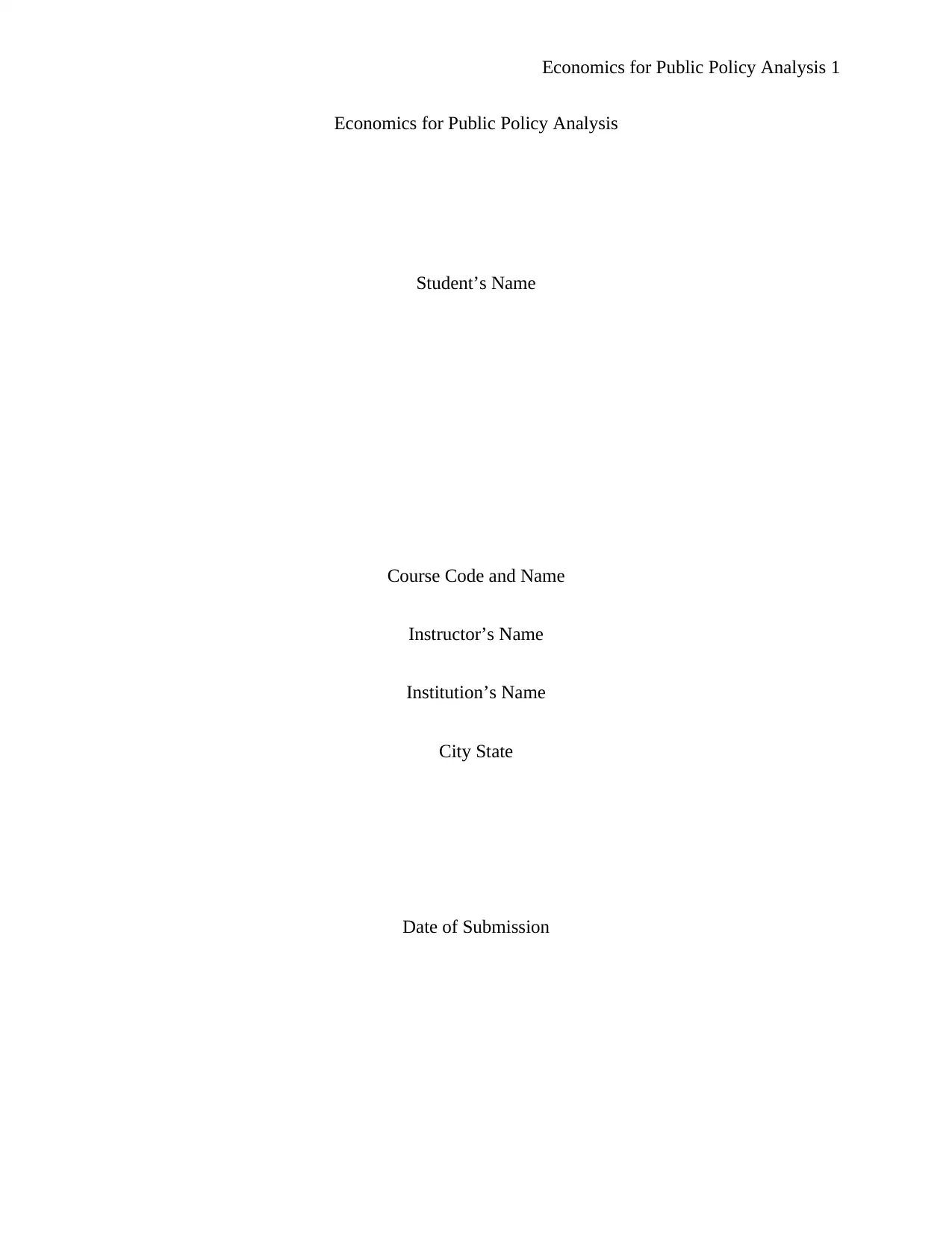
Economics for Public Policy Analysis 1
Economics for Public Policy Analysis
Student’s Name
Course Code and Name
Instructor’s Name
Institution’s Name
City State
Date of Submission
Economics for Public Policy Analysis
Student’s Name
Course Code and Name
Instructor’s Name
Institution’s Name
City State
Date of Submission
Paraphrase This Document
Need a fresh take? Get an instant paraphrase of this document with our AI Paraphraser
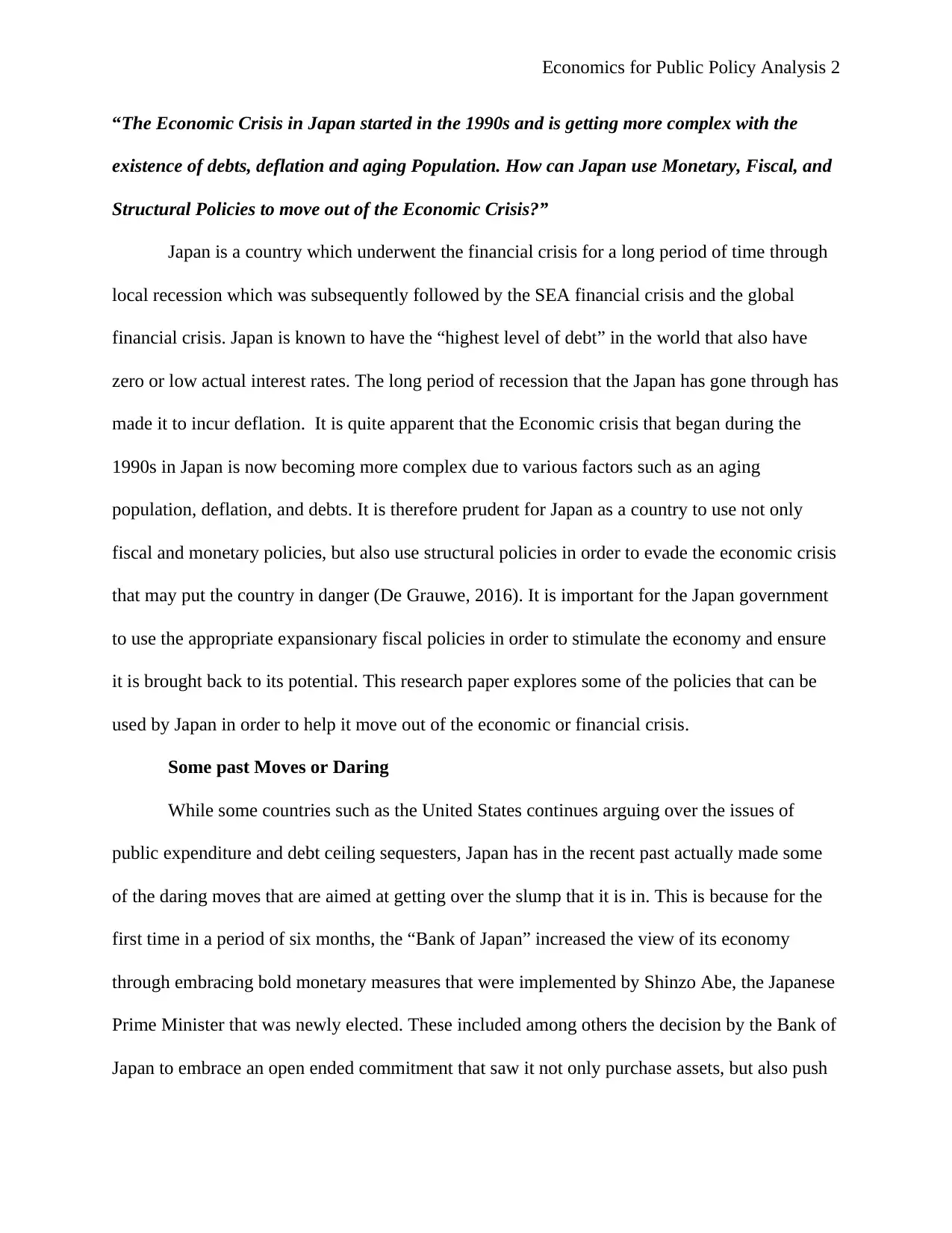
Economics for Public Policy Analysis 2
“The Economic Crisis in Japan started in the 1990s and is getting more complex with the
existence of debts, deflation and aging Population. How can Japan use Monetary, Fiscal, and
Structural Policies to move out of the Economic Crisis?”
Japan is a country which underwent the financial crisis for a long period of time through
local recession which was subsequently followed by the SEA financial crisis and the global
financial crisis. Japan is known to have the “highest level of debt” in the world that also have
zero or low actual interest rates. The long period of recession that the Japan has gone through has
made it to incur deflation. It is quite apparent that the Economic crisis that began during the
1990s in Japan is now becoming more complex due to various factors such as an aging
population, deflation, and debts. It is therefore prudent for Japan as a country to use not only
fiscal and monetary policies, but also use structural policies in order to evade the economic crisis
that may put the country in danger (De Grauwe, 2016). It is important for the Japan government
to use the appropriate expansionary fiscal policies in order to stimulate the economy and ensure
it is brought back to its potential. This research paper explores some of the policies that can be
used by Japan in order to help it move out of the economic or financial crisis.
Some past Moves or Daring
While some countries such as the United States continues arguing over the issues of
public expenditure and debt ceiling sequesters, Japan has in the recent past actually made some
of the daring moves that are aimed at getting over the slump that it is in. This is because for the
first time in a period of six months, the “Bank of Japan” increased the view of its economy
through embracing bold monetary measures that were implemented by Shinzo Abe, the Japanese
Prime Minister that was newly elected. These included among others the decision by the Bank of
Japan to embrace an open ended commitment that saw it not only purchase assets, but also push
“The Economic Crisis in Japan started in the 1990s and is getting more complex with the
existence of debts, deflation and aging Population. How can Japan use Monetary, Fiscal, and
Structural Policies to move out of the Economic Crisis?”
Japan is a country which underwent the financial crisis for a long period of time through
local recession which was subsequently followed by the SEA financial crisis and the global
financial crisis. Japan is known to have the “highest level of debt” in the world that also have
zero or low actual interest rates. The long period of recession that the Japan has gone through has
made it to incur deflation. It is quite apparent that the Economic crisis that began during the
1990s in Japan is now becoming more complex due to various factors such as an aging
population, deflation, and debts. It is therefore prudent for Japan as a country to use not only
fiscal and monetary policies, but also use structural policies in order to evade the economic crisis
that may put the country in danger (De Grauwe, 2016). It is important for the Japan government
to use the appropriate expansionary fiscal policies in order to stimulate the economy and ensure
it is brought back to its potential. This research paper explores some of the policies that can be
used by Japan in order to help it move out of the economic or financial crisis.
Some past Moves or Daring
While some countries such as the United States continues arguing over the issues of
public expenditure and debt ceiling sequesters, Japan has in the recent past actually made some
of the daring moves that are aimed at getting over the slump that it is in. This is because for the
first time in a period of six months, the “Bank of Japan” increased the view of its economy
through embracing bold monetary measures that were implemented by Shinzo Abe, the Japanese
Prime Minister that was newly elected. These included among others the decision by the Bank of
Japan to embrace an open ended commitment that saw it not only purchase assets, but also push
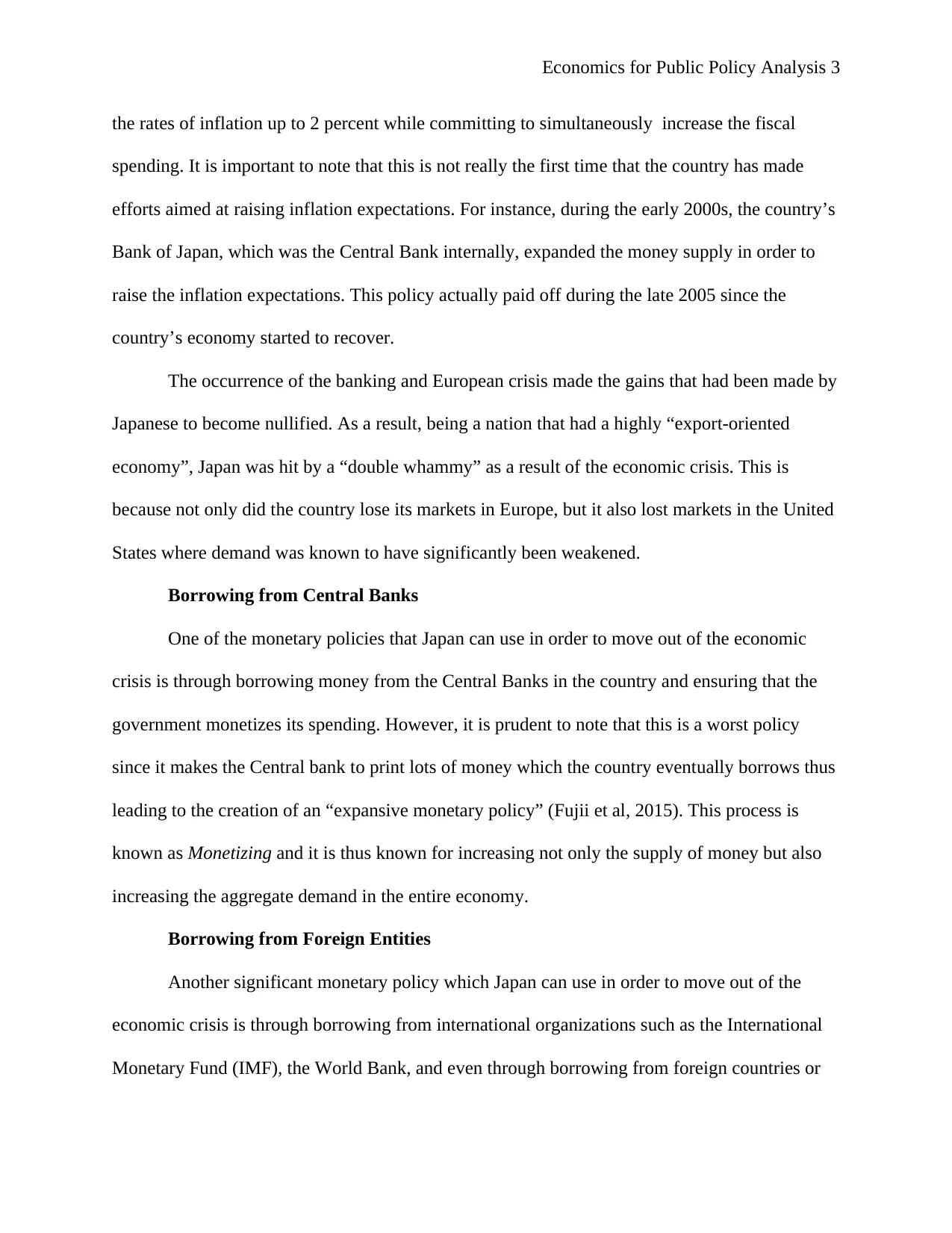
Economics for Public Policy Analysis 3
the rates of inflation up to 2 percent while committing to simultaneously increase the fiscal
spending. It is important to note that this is not really the first time that the country has made
efforts aimed at raising inflation expectations. For instance, during the early 2000s, the country’s
Bank of Japan, which was the Central Bank internally, expanded the money supply in order to
raise the inflation expectations. This policy actually paid off during the late 2005 since the
country’s economy started to recover.
The occurrence of the banking and European crisis made the gains that had been made by
Japanese to become nullified. As a result, being a nation that had a highly “export-oriented
economy”, Japan was hit by a “double whammy” as a result of the economic crisis. This is
because not only did the country lose its markets in Europe, but it also lost markets in the United
States where demand was known to have significantly been weakened.
Borrowing from Central Banks
One of the monetary policies that Japan can use in order to move out of the economic
crisis is through borrowing money from the Central Banks in the country and ensuring that the
government monetizes its spending. However, it is prudent to note that this is a worst policy
since it makes the Central bank to print lots of money which the country eventually borrows thus
leading to the creation of an “expansive monetary policy” (Fujii et al, 2015). This process is
known as Monetizing and it is thus known for increasing not only the supply of money but also
increasing the aggregate demand in the entire economy.
Borrowing from Foreign Entities
Another significant monetary policy which Japan can use in order to move out of the
economic crisis is through borrowing from international organizations such as the International
Monetary Fund (IMF), the World Bank, and even through borrowing from foreign countries or
the rates of inflation up to 2 percent while committing to simultaneously increase the fiscal
spending. It is important to note that this is not really the first time that the country has made
efforts aimed at raising inflation expectations. For instance, during the early 2000s, the country’s
Bank of Japan, which was the Central Bank internally, expanded the money supply in order to
raise the inflation expectations. This policy actually paid off during the late 2005 since the
country’s economy started to recover.
The occurrence of the banking and European crisis made the gains that had been made by
Japanese to become nullified. As a result, being a nation that had a highly “export-oriented
economy”, Japan was hit by a “double whammy” as a result of the economic crisis. This is
because not only did the country lose its markets in Europe, but it also lost markets in the United
States where demand was known to have significantly been weakened.
Borrowing from Central Banks
One of the monetary policies that Japan can use in order to move out of the economic
crisis is through borrowing money from the Central Banks in the country and ensuring that the
government monetizes its spending. However, it is prudent to note that this is a worst policy
since it makes the Central bank to print lots of money which the country eventually borrows thus
leading to the creation of an “expansive monetary policy” (Fujii et al, 2015). This process is
known as Monetizing and it is thus known for increasing not only the supply of money but also
increasing the aggregate demand in the entire economy.
Borrowing from Foreign Entities
Another significant monetary policy which Japan can use in order to move out of the
economic crisis is through borrowing from international organizations such as the International
Monetary Fund (IMF), the World Bank, and even through borrowing from foreign countries or
⊘ This is a preview!⊘
Do you want full access?
Subscribe today to unlock all pages.

Trusted by 1+ million students worldwide
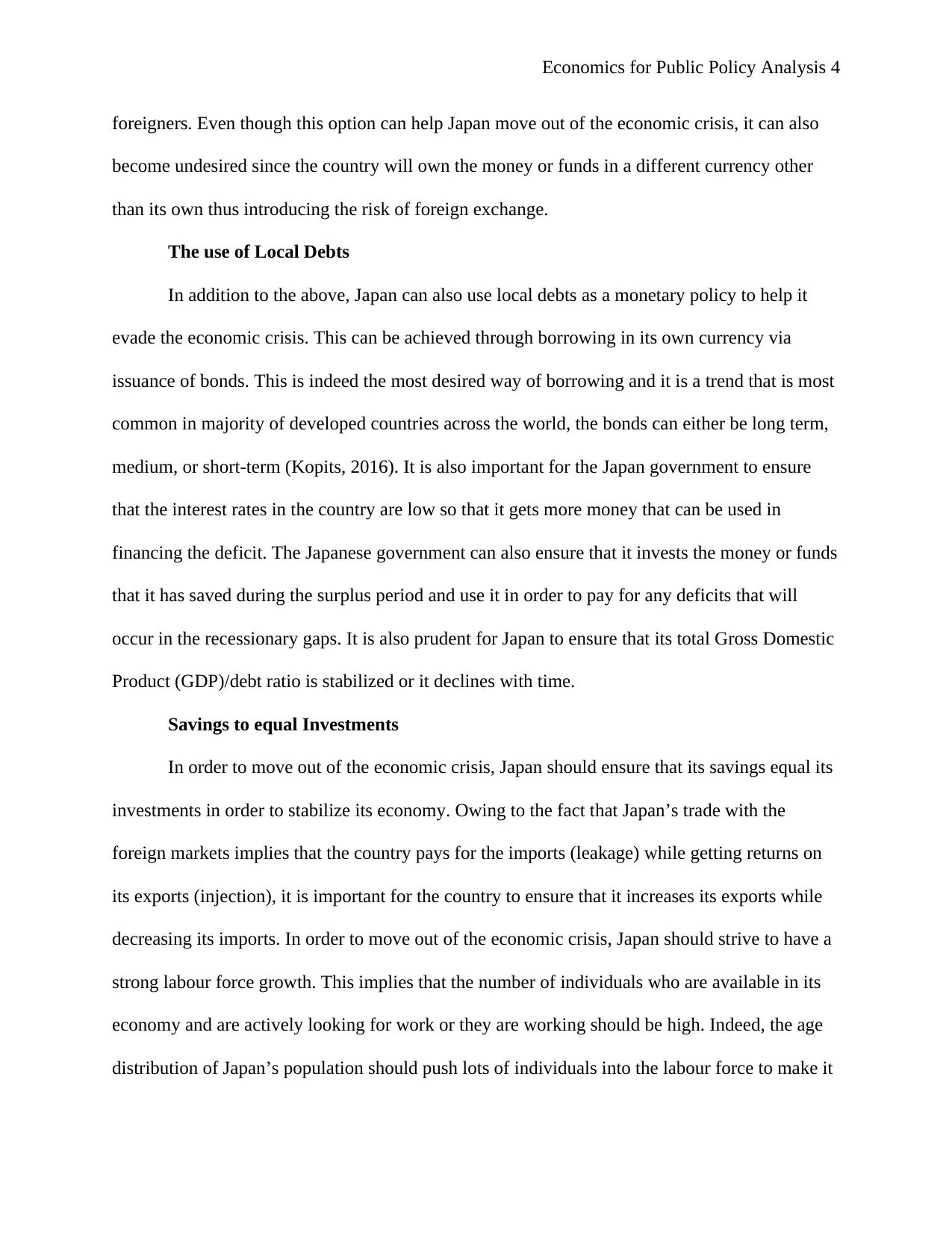
Economics for Public Policy Analysis 4
foreigners. Even though this option can help Japan move out of the economic crisis, it can also
become undesired since the country will own the money or funds in a different currency other
than its own thus introducing the risk of foreign exchange.
The use of Local Debts
In addition to the above, Japan can also use local debts as a monetary policy to help it
evade the economic crisis. This can be achieved through borrowing in its own currency via
issuance of bonds. This is indeed the most desired way of borrowing and it is a trend that is most
common in majority of developed countries across the world, the bonds can either be long term,
medium, or short-term (Kopits, 2016). It is also important for the Japan government to ensure
that the interest rates in the country are low so that it gets more money that can be used in
financing the deficit. The Japanese government can also ensure that it invests the money or funds
that it has saved during the surplus period and use it in order to pay for any deficits that will
occur in the recessionary gaps. It is also prudent for Japan to ensure that its total Gross Domestic
Product (GDP)/debt ratio is stabilized or it declines with time.
Savings to equal Investments
In order to move out of the economic crisis, Japan should ensure that its savings equal its
investments in order to stabilize its economy. Owing to the fact that Japan’s trade with the
foreign markets implies that the country pays for the imports (leakage) while getting returns on
its exports (injection), it is important for the country to ensure that it increases its exports while
decreasing its imports. In order to move out of the economic crisis, Japan should strive to have a
strong labour force growth. This implies that the number of individuals who are available in its
economy and are actively looking for work or they are working should be high. Indeed, the age
distribution of Japan’s population should push lots of individuals into the labour force to make it
foreigners. Even though this option can help Japan move out of the economic crisis, it can also
become undesired since the country will own the money or funds in a different currency other
than its own thus introducing the risk of foreign exchange.
The use of Local Debts
In addition to the above, Japan can also use local debts as a monetary policy to help it
evade the economic crisis. This can be achieved through borrowing in its own currency via
issuance of bonds. This is indeed the most desired way of borrowing and it is a trend that is most
common in majority of developed countries across the world, the bonds can either be long term,
medium, or short-term (Kopits, 2016). It is also important for the Japan government to ensure
that the interest rates in the country are low so that it gets more money that can be used in
financing the deficit. The Japanese government can also ensure that it invests the money or funds
that it has saved during the surplus period and use it in order to pay for any deficits that will
occur in the recessionary gaps. It is also prudent for Japan to ensure that its total Gross Domestic
Product (GDP)/debt ratio is stabilized or it declines with time.
Savings to equal Investments
In order to move out of the economic crisis, Japan should ensure that its savings equal its
investments in order to stabilize its economy. Owing to the fact that Japan’s trade with the
foreign markets implies that the country pays for the imports (leakage) while getting returns on
its exports (injection), it is important for the country to ensure that it increases its exports while
decreasing its imports. In order to move out of the economic crisis, Japan should strive to have a
strong labour force growth. This implies that the number of individuals who are available in its
economy and are actively looking for work or they are working should be high. Indeed, the age
distribution of Japan’s population should push lots of individuals into the labour force to make it
Paraphrase This Document
Need a fresh take? Get an instant paraphrase of this document with our AI Paraphraser
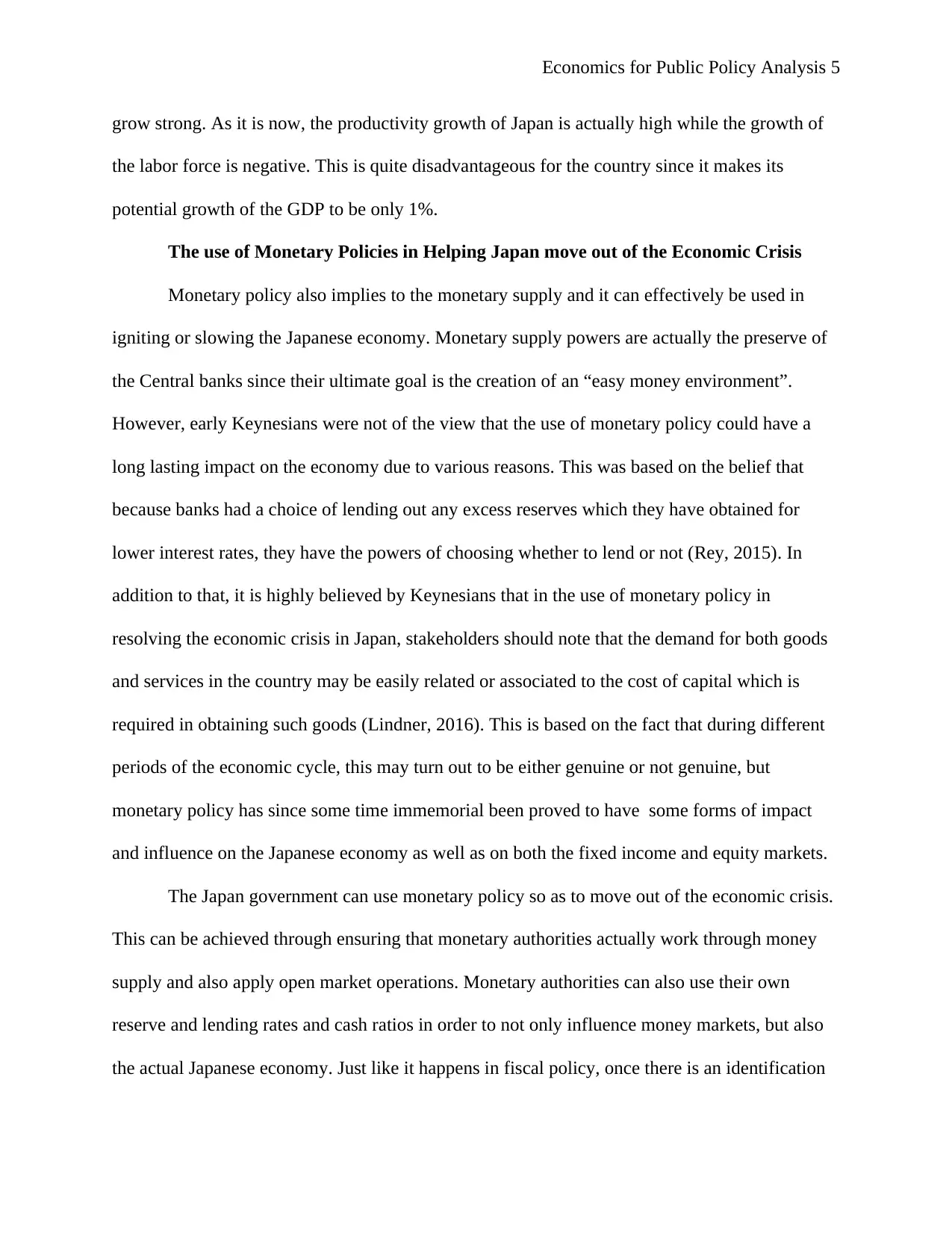
Economics for Public Policy Analysis 5
grow strong. As it is now, the productivity growth of Japan is actually high while the growth of
the labor force is negative. This is quite disadvantageous for the country since it makes its
potential growth of the GDP to be only 1%.
The use of Monetary Policies in Helping Japan move out of the Economic Crisis
Monetary policy also implies to the monetary supply and it can effectively be used in
igniting or slowing the Japanese economy. Monetary supply powers are actually the preserve of
the Central banks since their ultimate goal is the creation of an “easy money environment”.
However, early Keynesians were not of the view that the use of monetary policy could have a
long lasting impact on the economy due to various reasons. This was based on the belief that
because banks had a choice of lending out any excess reserves which they have obtained for
lower interest rates, they have the powers of choosing whether to lend or not (Rey, 2015). In
addition to that, it is highly believed by Keynesians that in the use of monetary policy in
resolving the economic crisis in Japan, stakeholders should note that the demand for both goods
and services in the country may be easily related or associated to the cost of capital which is
required in obtaining such goods (Lindner, 2016). This is based on the fact that during different
periods of the economic cycle, this may turn out to be either genuine or not genuine, but
monetary policy has since some time immemorial been proved to have some forms of impact
and influence on the Japanese economy as well as on both the fixed income and equity markets.
The Japan government can use monetary policy so as to move out of the economic crisis.
This can be achieved through ensuring that monetary authorities actually work through money
supply and also apply open market operations. Monetary authorities can also use their own
reserve and lending rates and cash ratios in order to not only influence money markets, but also
the actual Japanese economy. Just like it happens in fiscal policy, once there is an identification
grow strong. As it is now, the productivity growth of Japan is actually high while the growth of
the labor force is negative. This is quite disadvantageous for the country since it makes its
potential growth of the GDP to be only 1%.
The use of Monetary Policies in Helping Japan move out of the Economic Crisis
Monetary policy also implies to the monetary supply and it can effectively be used in
igniting or slowing the Japanese economy. Monetary supply powers are actually the preserve of
the Central banks since their ultimate goal is the creation of an “easy money environment”.
However, early Keynesians were not of the view that the use of monetary policy could have a
long lasting impact on the economy due to various reasons. This was based on the belief that
because banks had a choice of lending out any excess reserves which they have obtained for
lower interest rates, they have the powers of choosing whether to lend or not (Rey, 2015). In
addition to that, it is highly believed by Keynesians that in the use of monetary policy in
resolving the economic crisis in Japan, stakeholders should note that the demand for both goods
and services in the country may be easily related or associated to the cost of capital which is
required in obtaining such goods (Lindner, 2016). This is based on the fact that during different
periods of the economic cycle, this may turn out to be either genuine or not genuine, but
monetary policy has since some time immemorial been proved to have some forms of impact
and influence on the Japanese economy as well as on both the fixed income and equity markets.
The Japan government can use monetary policy so as to move out of the economic crisis.
This can be achieved through ensuring that monetary authorities actually work through money
supply and also apply open market operations. Monetary authorities can also use their own
reserve and lending rates and cash ratios in order to not only influence money markets, but also
the actual Japanese economy. Just like it happens in fiscal policy, once there is an identification
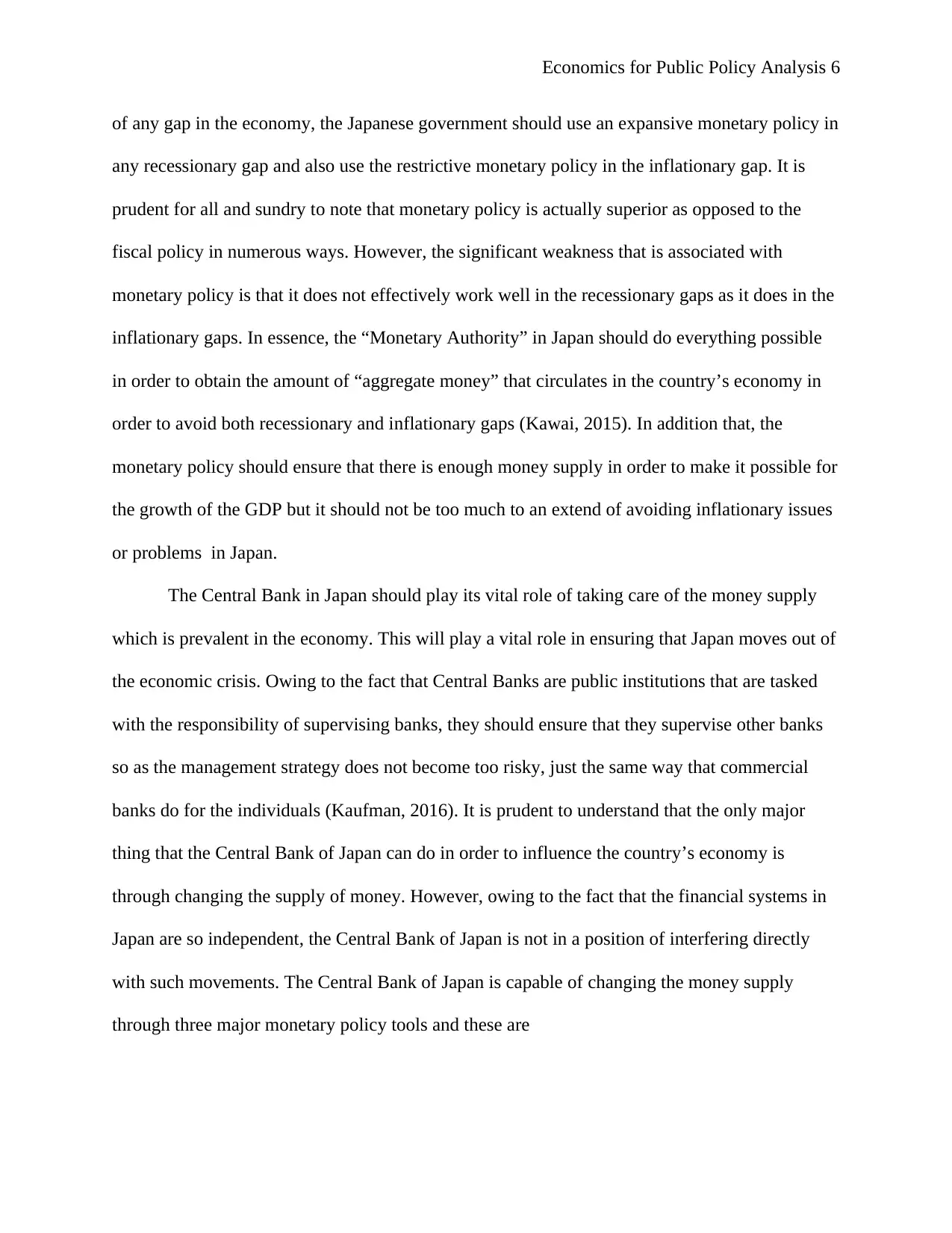
Economics for Public Policy Analysis 6
of any gap in the economy, the Japanese government should use an expansive monetary policy in
any recessionary gap and also use the restrictive monetary policy in the inflationary gap. It is
prudent for all and sundry to note that monetary policy is actually superior as opposed to the
fiscal policy in numerous ways. However, the significant weakness that is associated with
monetary policy is that it does not effectively work well in the recessionary gaps as it does in the
inflationary gaps. In essence, the “Monetary Authority” in Japan should do everything possible
in order to obtain the amount of “aggregate money” that circulates in the country’s economy in
order to avoid both recessionary and inflationary gaps (Kawai, 2015). In addition that, the
monetary policy should ensure that there is enough money supply in order to make it possible for
the growth of the GDP but it should not be too much to an extend of avoiding inflationary issues
or problems in Japan.
The Central Bank in Japan should play its vital role of taking care of the money supply
which is prevalent in the economy. This will play a vital role in ensuring that Japan moves out of
the economic crisis. Owing to the fact that Central Banks are public institutions that are tasked
with the responsibility of supervising banks, they should ensure that they supervise other banks
so as the management strategy does not become too risky, just the same way that commercial
banks do for the individuals (Kaufman, 2016). It is prudent to understand that the only major
thing that the Central Bank of Japan can do in order to influence the country’s economy is
through changing the supply of money. However, owing to the fact that the financial systems in
Japan are so independent, the Central Bank of Japan is not in a position of interfering directly
with such movements. The Central Bank of Japan is capable of changing the money supply
through three major monetary policy tools and these are
of any gap in the economy, the Japanese government should use an expansive monetary policy in
any recessionary gap and also use the restrictive monetary policy in the inflationary gap. It is
prudent for all and sundry to note that monetary policy is actually superior as opposed to the
fiscal policy in numerous ways. However, the significant weakness that is associated with
monetary policy is that it does not effectively work well in the recessionary gaps as it does in the
inflationary gaps. In essence, the “Monetary Authority” in Japan should do everything possible
in order to obtain the amount of “aggregate money” that circulates in the country’s economy in
order to avoid both recessionary and inflationary gaps (Kawai, 2015). In addition that, the
monetary policy should ensure that there is enough money supply in order to make it possible for
the growth of the GDP but it should not be too much to an extend of avoiding inflationary issues
or problems in Japan.
The Central Bank in Japan should play its vital role of taking care of the money supply
which is prevalent in the economy. This will play a vital role in ensuring that Japan moves out of
the economic crisis. Owing to the fact that Central Banks are public institutions that are tasked
with the responsibility of supervising banks, they should ensure that they supervise other banks
so as the management strategy does not become too risky, just the same way that commercial
banks do for the individuals (Kaufman, 2016). It is prudent to understand that the only major
thing that the Central Bank of Japan can do in order to influence the country’s economy is
through changing the supply of money. However, owing to the fact that the financial systems in
Japan are so independent, the Central Bank of Japan is not in a position of interfering directly
with such movements. The Central Bank of Japan is capable of changing the money supply
through three major monetary policy tools and these are
⊘ This is a preview!⊘
Do you want full access?
Subscribe today to unlock all pages.

Trusted by 1+ million students worldwide
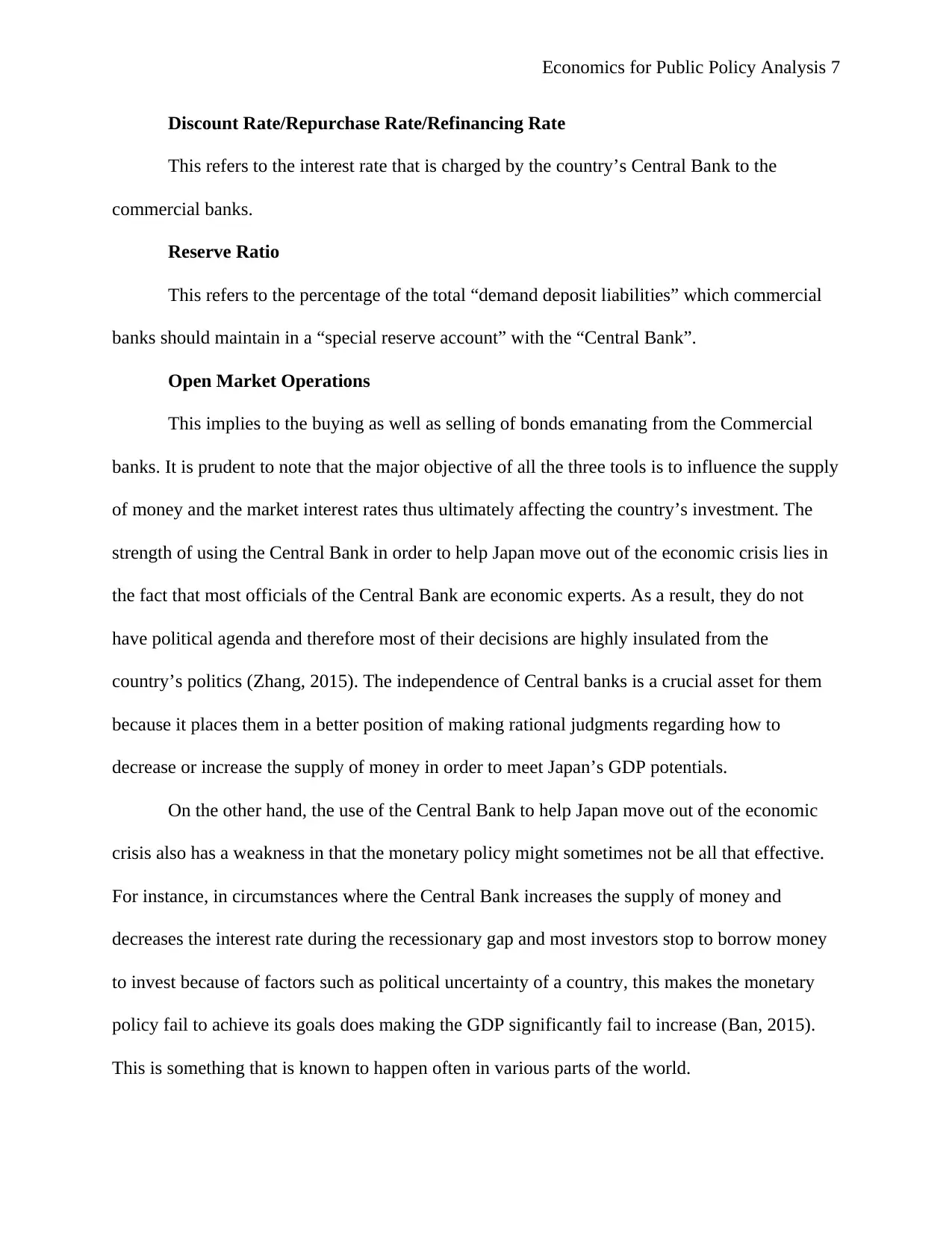
Economics for Public Policy Analysis 7
Discount Rate/Repurchase Rate/Refinancing Rate
This refers to the interest rate that is charged by the country’s Central Bank to the
commercial banks.
Reserve Ratio
This refers to the percentage of the total “demand deposit liabilities” which commercial
banks should maintain in a “special reserve account” with the “Central Bank”.
Open Market Operations
This implies to the buying as well as selling of bonds emanating from the Commercial
banks. It is prudent to note that the major objective of all the three tools is to influence the supply
of money and the market interest rates thus ultimately affecting the country’s investment. The
strength of using the Central Bank in order to help Japan move out of the economic crisis lies in
the fact that most officials of the Central Bank are economic experts. As a result, they do not
have political agenda and therefore most of their decisions are highly insulated from the
country’s politics (Zhang, 2015). The independence of Central banks is a crucial asset for them
because it places them in a better position of making rational judgments regarding how to
decrease or increase the supply of money in order to meet Japan’s GDP potentials.
On the other hand, the use of the Central Bank to help Japan move out of the economic
crisis also has a weakness in that the monetary policy might sometimes not be all that effective.
For instance, in circumstances where the Central Bank increases the supply of money and
decreases the interest rate during the recessionary gap and most investors stop to borrow money
to invest because of factors such as political uncertainty of a country, this makes the monetary
policy fail to achieve its goals does making the GDP significantly fail to increase (Ban, 2015).
This is something that is known to happen often in various parts of the world.
Discount Rate/Repurchase Rate/Refinancing Rate
This refers to the interest rate that is charged by the country’s Central Bank to the
commercial banks.
Reserve Ratio
This refers to the percentage of the total “demand deposit liabilities” which commercial
banks should maintain in a “special reserve account” with the “Central Bank”.
Open Market Operations
This implies to the buying as well as selling of bonds emanating from the Commercial
banks. It is prudent to note that the major objective of all the three tools is to influence the supply
of money and the market interest rates thus ultimately affecting the country’s investment. The
strength of using the Central Bank in order to help Japan move out of the economic crisis lies in
the fact that most officials of the Central Bank are economic experts. As a result, they do not
have political agenda and therefore most of their decisions are highly insulated from the
country’s politics (Zhang, 2015). The independence of Central banks is a crucial asset for them
because it places them in a better position of making rational judgments regarding how to
decrease or increase the supply of money in order to meet Japan’s GDP potentials.
On the other hand, the use of the Central Bank to help Japan move out of the economic
crisis also has a weakness in that the monetary policy might sometimes not be all that effective.
For instance, in circumstances where the Central Bank increases the supply of money and
decreases the interest rate during the recessionary gap and most investors stop to borrow money
to invest because of factors such as political uncertainty of a country, this makes the monetary
policy fail to achieve its goals does making the GDP significantly fail to increase (Ban, 2015).
This is something that is known to happen often in various parts of the world.
Paraphrase This Document
Need a fresh take? Get an instant paraphrase of this document with our AI Paraphraser
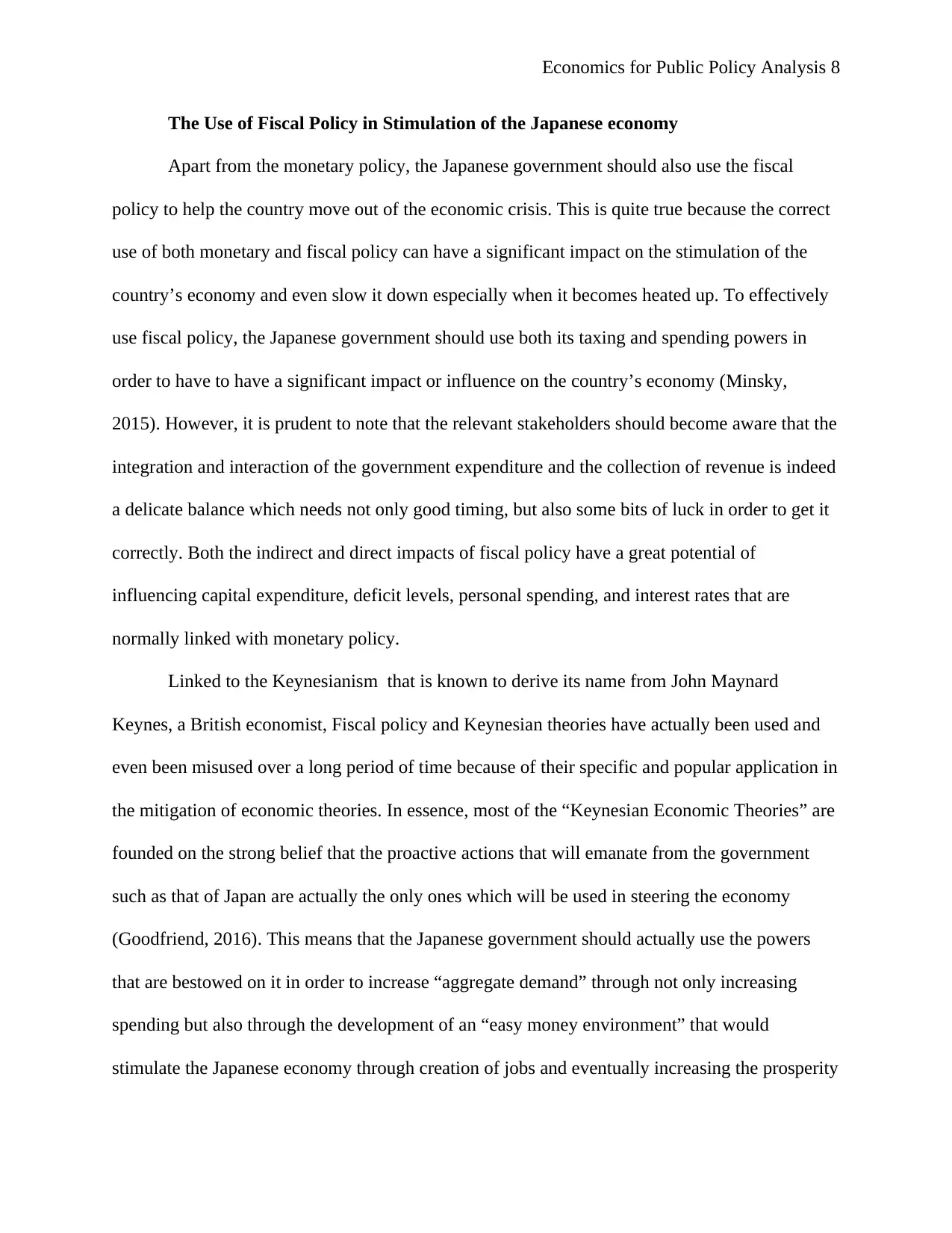
Economics for Public Policy Analysis 8
The Use of Fiscal Policy in Stimulation of the Japanese economy
Apart from the monetary policy, the Japanese government should also use the fiscal
policy to help the country move out of the economic crisis. This is quite true because the correct
use of both monetary and fiscal policy can have a significant impact on the stimulation of the
country’s economy and even slow it down especially when it becomes heated up. To effectively
use fiscal policy, the Japanese government should use both its taxing and spending powers in
order to have to have a significant impact or influence on the country’s economy (Minsky,
2015). However, it is prudent to note that the relevant stakeholders should become aware that the
integration and interaction of the government expenditure and the collection of revenue is indeed
a delicate balance which needs not only good timing, but also some bits of luck in order to get it
correctly. Both the indirect and direct impacts of fiscal policy have a great potential of
influencing capital expenditure, deficit levels, personal spending, and interest rates that are
normally linked with monetary policy.
Linked to the Keynesianism that is known to derive its name from John Maynard
Keynes, a British economist, Fiscal policy and Keynesian theories have actually been used and
even been misused over a long period of time because of their specific and popular application in
the mitigation of economic theories. In essence, most of the “Keynesian Economic Theories” are
founded on the strong belief that the proactive actions that will emanate from the government
such as that of Japan are actually the only ones which will be used in steering the economy
(Goodfriend, 2016). This means that the Japanese government should actually use the powers
that are bestowed on it in order to increase “aggregate demand” through not only increasing
spending but also through the development of an “easy money environment” that would
stimulate the Japanese economy through creation of jobs and eventually increasing the prosperity
The Use of Fiscal Policy in Stimulation of the Japanese economy
Apart from the monetary policy, the Japanese government should also use the fiscal
policy to help the country move out of the economic crisis. This is quite true because the correct
use of both monetary and fiscal policy can have a significant impact on the stimulation of the
country’s economy and even slow it down especially when it becomes heated up. To effectively
use fiscal policy, the Japanese government should use both its taxing and spending powers in
order to have to have a significant impact or influence on the country’s economy (Minsky,
2015). However, it is prudent to note that the relevant stakeholders should become aware that the
integration and interaction of the government expenditure and the collection of revenue is indeed
a delicate balance which needs not only good timing, but also some bits of luck in order to get it
correctly. Both the indirect and direct impacts of fiscal policy have a great potential of
influencing capital expenditure, deficit levels, personal spending, and interest rates that are
normally linked with monetary policy.
Linked to the Keynesianism that is known to derive its name from John Maynard
Keynes, a British economist, Fiscal policy and Keynesian theories have actually been used and
even been misused over a long period of time because of their specific and popular application in
the mitigation of economic theories. In essence, most of the “Keynesian Economic Theories” are
founded on the strong belief that the proactive actions that will emanate from the government
such as that of Japan are actually the only ones which will be used in steering the economy
(Goodfriend, 2016). This means that the Japanese government should actually use the powers
that are bestowed on it in order to increase “aggregate demand” through not only increasing
spending but also through the development of an “easy money environment” that would
stimulate the Japanese economy through creation of jobs and eventually increasing the prosperity
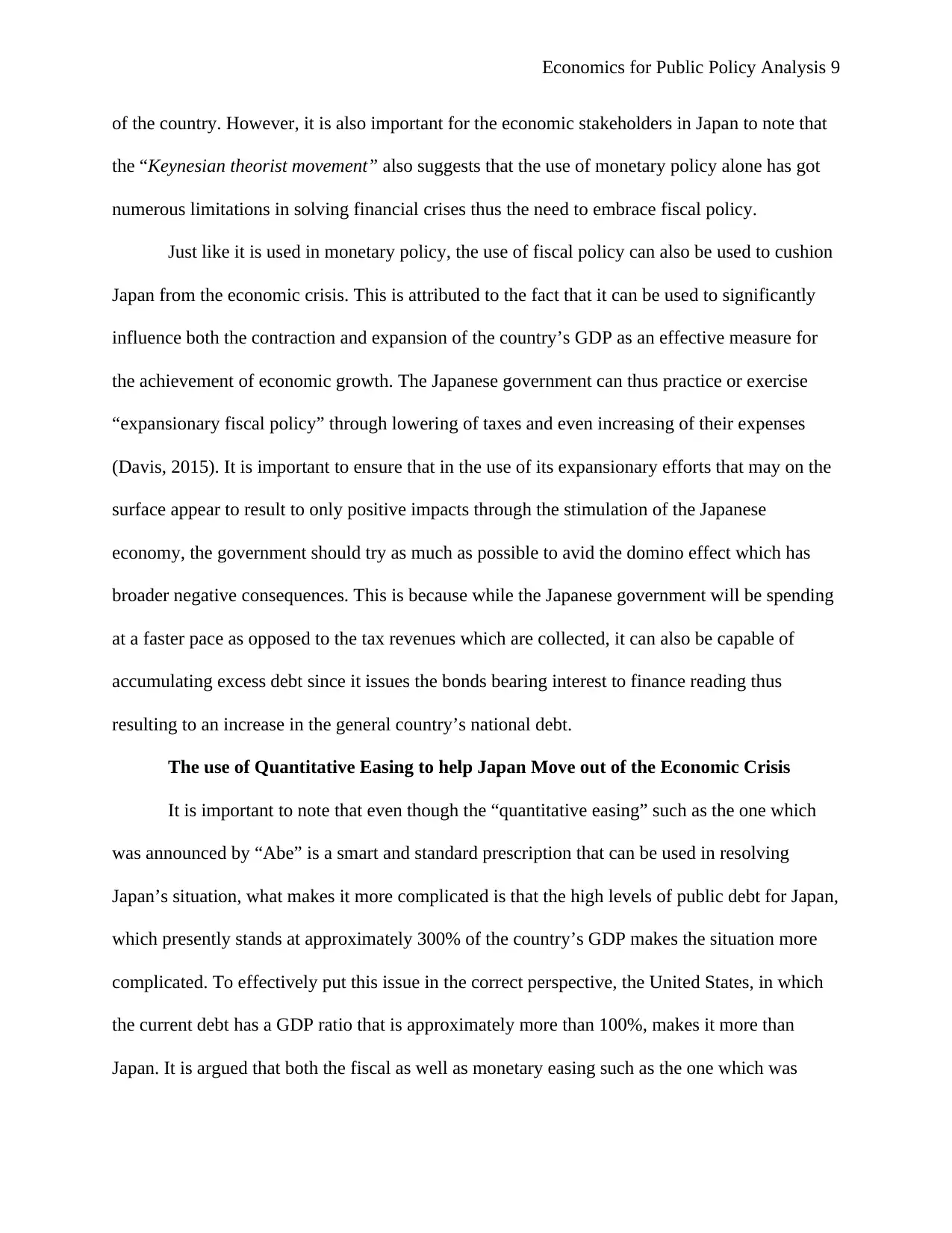
Economics for Public Policy Analysis 9
of the country. However, it is also important for the economic stakeholders in Japan to note that
the “Keynesian theorist movement” also suggests that the use of monetary policy alone has got
numerous limitations in solving financial crises thus the need to embrace fiscal policy.
Just like it is used in monetary policy, the use of fiscal policy can also be used to cushion
Japan from the economic crisis. This is attributed to the fact that it can be used to significantly
influence both the contraction and expansion of the country’s GDP as an effective measure for
the achievement of economic growth. The Japanese government can thus practice or exercise
“expansionary fiscal policy” through lowering of taxes and even increasing of their expenses
(Davis, 2015). It is important to ensure that in the use of its expansionary efforts that may on the
surface appear to result to only positive impacts through the stimulation of the Japanese
economy, the government should try as much as possible to avid the domino effect which has
broader negative consequences. This is because while the Japanese government will be spending
at a faster pace as opposed to the tax revenues which are collected, it can also be capable of
accumulating excess debt since it issues the bonds bearing interest to finance reading thus
resulting to an increase in the general country’s national debt.
The use of Quantitative Easing to help Japan Move out of the Economic Crisis
It is important to note that even though the “quantitative easing” such as the one which
was announced by “Abe” is a smart and standard prescription that can be used in resolving
Japan’s situation, what makes it more complicated is that the high levels of public debt for Japan,
which presently stands at approximately 300% of the country’s GDP makes the situation more
complicated. To effectively put this issue in the correct perspective, the United States, in which
the current debt has a GDP ratio that is approximately more than 100%, makes it more than
Japan. It is argued that both the fiscal as well as monetary easing such as the one which was
of the country. However, it is also important for the economic stakeholders in Japan to note that
the “Keynesian theorist movement” also suggests that the use of monetary policy alone has got
numerous limitations in solving financial crises thus the need to embrace fiscal policy.
Just like it is used in monetary policy, the use of fiscal policy can also be used to cushion
Japan from the economic crisis. This is attributed to the fact that it can be used to significantly
influence both the contraction and expansion of the country’s GDP as an effective measure for
the achievement of economic growth. The Japanese government can thus practice or exercise
“expansionary fiscal policy” through lowering of taxes and even increasing of their expenses
(Davis, 2015). It is important to ensure that in the use of its expansionary efforts that may on the
surface appear to result to only positive impacts through the stimulation of the Japanese
economy, the government should try as much as possible to avid the domino effect which has
broader negative consequences. This is because while the Japanese government will be spending
at a faster pace as opposed to the tax revenues which are collected, it can also be capable of
accumulating excess debt since it issues the bonds bearing interest to finance reading thus
resulting to an increase in the general country’s national debt.
The use of Quantitative Easing to help Japan Move out of the Economic Crisis
It is important to note that even though the “quantitative easing” such as the one which
was announced by “Abe” is a smart and standard prescription that can be used in resolving
Japan’s situation, what makes it more complicated is that the high levels of public debt for Japan,
which presently stands at approximately 300% of the country’s GDP makes the situation more
complicated. To effectively put this issue in the correct perspective, the United States, in which
the current debt has a GDP ratio that is approximately more than 100%, makes it more than
Japan. It is argued that both the fiscal as well as monetary easing such as the one which was
⊘ This is a preview!⊘
Do you want full access?
Subscribe today to unlock all pages.

Trusted by 1+ million students worldwide
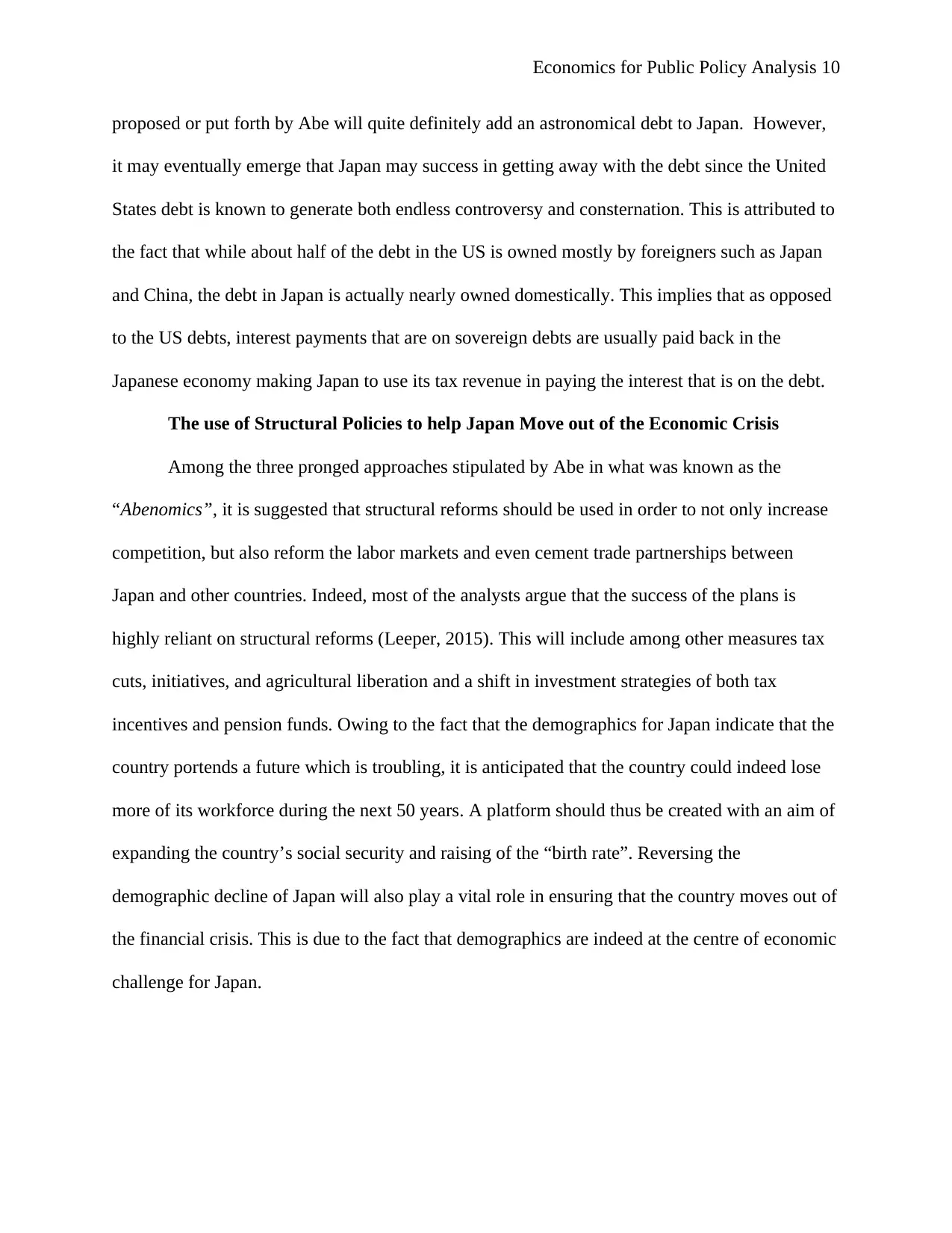
Economics for Public Policy Analysis 10
proposed or put forth by Abe will quite definitely add an astronomical debt to Japan. However,
it may eventually emerge that Japan may success in getting away with the debt since the United
States debt is known to generate both endless controversy and consternation. This is attributed to
the fact that while about half of the debt in the US is owned mostly by foreigners such as Japan
and China, the debt in Japan is actually nearly owned domestically. This implies that as opposed
to the US debts, interest payments that are on sovereign debts are usually paid back in the
Japanese economy making Japan to use its tax revenue in paying the interest that is on the debt.
The use of Structural Policies to help Japan Move out of the Economic Crisis
Among the three pronged approaches stipulated by Abe in what was known as the
“Abenomics”, it is suggested that structural reforms should be used in order to not only increase
competition, but also reform the labor markets and even cement trade partnerships between
Japan and other countries. Indeed, most of the analysts argue that the success of the plans is
highly reliant on structural reforms (Leeper, 2015). This will include among other measures tax
cuts, initiatives, and agricultural liberation and a shift in investment strategies of both tax
incentives and pension funds. Owing to the fact that the demographics for Japan indicate that the
country portends a future which is troubling, it is anticipated that the country could indeed lose
more of its workforce during the next 50 years. A platform should thus be created with an aim of
expanding the country’s social security and raising of the “birth rate”. Reversing the
demographic decline of Japan will also play a vital role in ensuring that the country moves out of
the financial crisis. This is due to the fact that demographics are indeed at the centre of economic
challenge for Japan.
proposed or put forth by Abe will quite definitely add an astronomical debt to Japan. However,
it may eventually emerge that Japan may success in getting away with the debt since the United
States debt is known to generate both endless controversy and consternation. This is attributed to
the fact that while about half of the debt in the US is owned mostly by foreigners such as Japan
and China, the debt in Japan is actually nearly owned domestically. This implies that as opposed
to the US debts, interest payments that are on sovereign debts are usually paid back in the
Japanese economy making Japan to use its tax revenue in paying the interest that is on the debt.
The use of Structural Policies to help Japan Move out of the Economic Crisis
Among the three pronged approaches stipulated by Abe in what was known as the
“Abenomics”, it is suggested that structural reforms should be used in order to not only increase
competition, but also reform the labor markets and even cement trade partnerships between
Japan and other countries. Indeed, most of the analysts argue that the success of the plans is
highly reliant on structural reforms (Leeper, 2015). This will include among other measures tax
cuts, initiatives, and agricultural liberation and a shift in investment strategies of both tax
incentives and pension funds. Owing to the fact that the demographics for Japan indicate that the
country portends a future which is troubling, it is anticipated that the country could indeed lose
more of its workforce during the next 50 years. A platform should thus be created with an aim of
expanding the country’s social security and raising of the “birth rate”. Reversing the
demographic decline of Japan will also play a vital role in ensuring that the country moves out of
the financial crisis. This is due to the fact that demographics are indeed at the centre of economic
challenge for Japan.
Paraphrase This Document
Need a fresh take? Get an instant paraphrase of this document with our AI Paraphraser
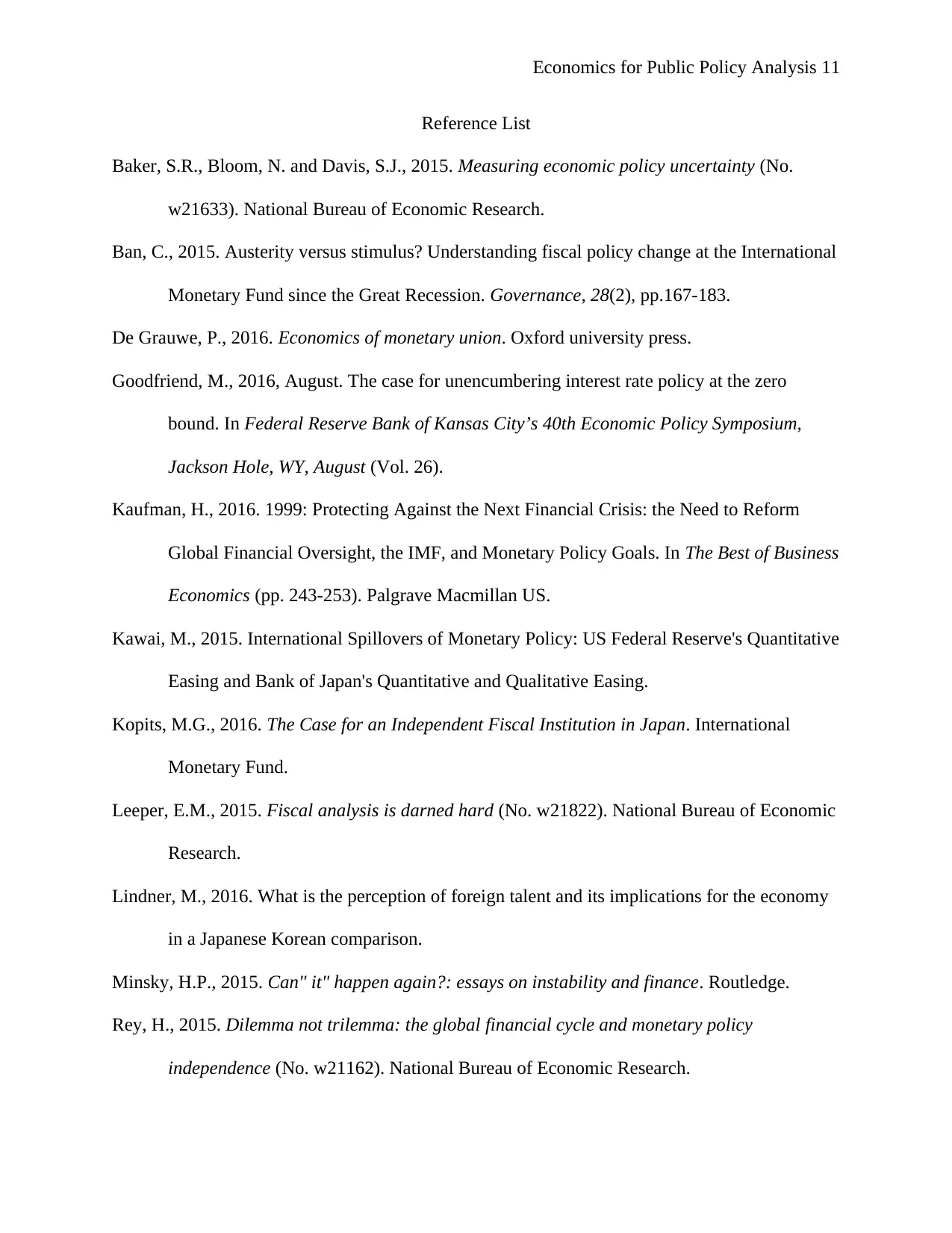
Economics for Public Policy Analysis 11
Reference List
Baker, S.R., Bloom, N. and Davis, S.J., 2015. Measuring economic policy uncertainty (No.
w21633). National Bureau of Economic Research.
Ban, C., 2015. Austerity versus stimulus? Understanding fiscal policy change at the International
Monetary Fund since the Great Recession. Governance, 28(2), pp.167-183.
De Grauwe, P., 2016. Economics of monetary union. Oxford university press.
Goodfriend, M., 2016, August. The case for unencumbering interest rate policy at the zero
bound. In Federal Reserve Bank of Kansas City’s 40th Economic Policy Symposium,
Jackson Hole, WY, August (Vol. 26).
Kaufman, H., 2016. 1999: Protecting Against the Next Financial Crisis: the Need to Reform
Global Financial Oversight, the IMF, and Monetary Policy Goals. In The Best of Business
Economics (pp. 243-253). Palgrave Macmillan US.
Kawai, M., 2015. International Spillovers of Monetary Policy: US Federal Reserve's Quantitative
Easing and Bank of Japan's Quantitative and Qualitative Easing.
Kopits, M.G., 2016. The Case for an Independent Fiscal Institution in Japan. International
Monetary Fund.
Leeper, E.M., 2015. Fiscal analysis is darned hard (No. w21822). National Bureau of Economic
Research.
Lindner, M., 2016. What is the perception of foreign talent and its implications for the economy
in a Japanese Korean comparison.
Minsky, H.P., 2015. Can" it" happen again?: essays on instability and finance. Routledge.
Rey, H., 2015. Dilemma not trilemma: the global financial cycle and monetary policy
independence (No. w21162). National Bureau of Economic Research.
Reference List
Baker, S.R., Bloom, N. and Davis, S.J., 2015. Measuring economic policy uncertainty (No.
w21633). National Bureau of Economic Research.
Ban, C., 2015. Austerity versus stimulus? Understanding fiscal policy change at the International
Monetary Fund since the Great Recession. Governance, 28(2), pp.167-183.
De Grauwe, P., 2016. Economics of monetary union. Oxford university press.
Goodfriend, M., 2016, August. The case for unencumbering interest rate policy at the zero
bound. In Federal Reserve Bank of Kansas City’s 40th Economic Policy Symposium,
Jackson Hole, WY, August (Vol. 26).
Kaufman, H., 2016. 1999: Protecting Against the Next Financial Crisis: the Need to Reform
Global Financial Oversight, the IMF, and Monetary Policy Goals. In The Best of Business
Economics (pp. 243-253). Palgrave Macmillan US.
Kawai, M., 2015. International Spillovers of Monetary Policy: US Federal Reserve's Quantitative
Easing and Bank of Japan's Quantitative and Qualitative Easing.
Kopits, M.G., 2016. The Case for an Independent Fiscal Institution in Japan. International
Monetary Fund.
Leeper, E.M., 2015. Fiscal analysis is darned hard (No. w21822). National Bureau of Economic
Research.
Lindner, M., 2016. What is the perception of foreign talent and its implications for the economy
in a Japanese Korean comparison.
Minsky, H.P., 2015. Can" it" happen again?: essays on instability and finance. Routledge.
Rey, H., 2015. Dilemma not trilemma: the global financial cycle and monetary policy
independence (No. w21162). National Bureau of Economic Research.
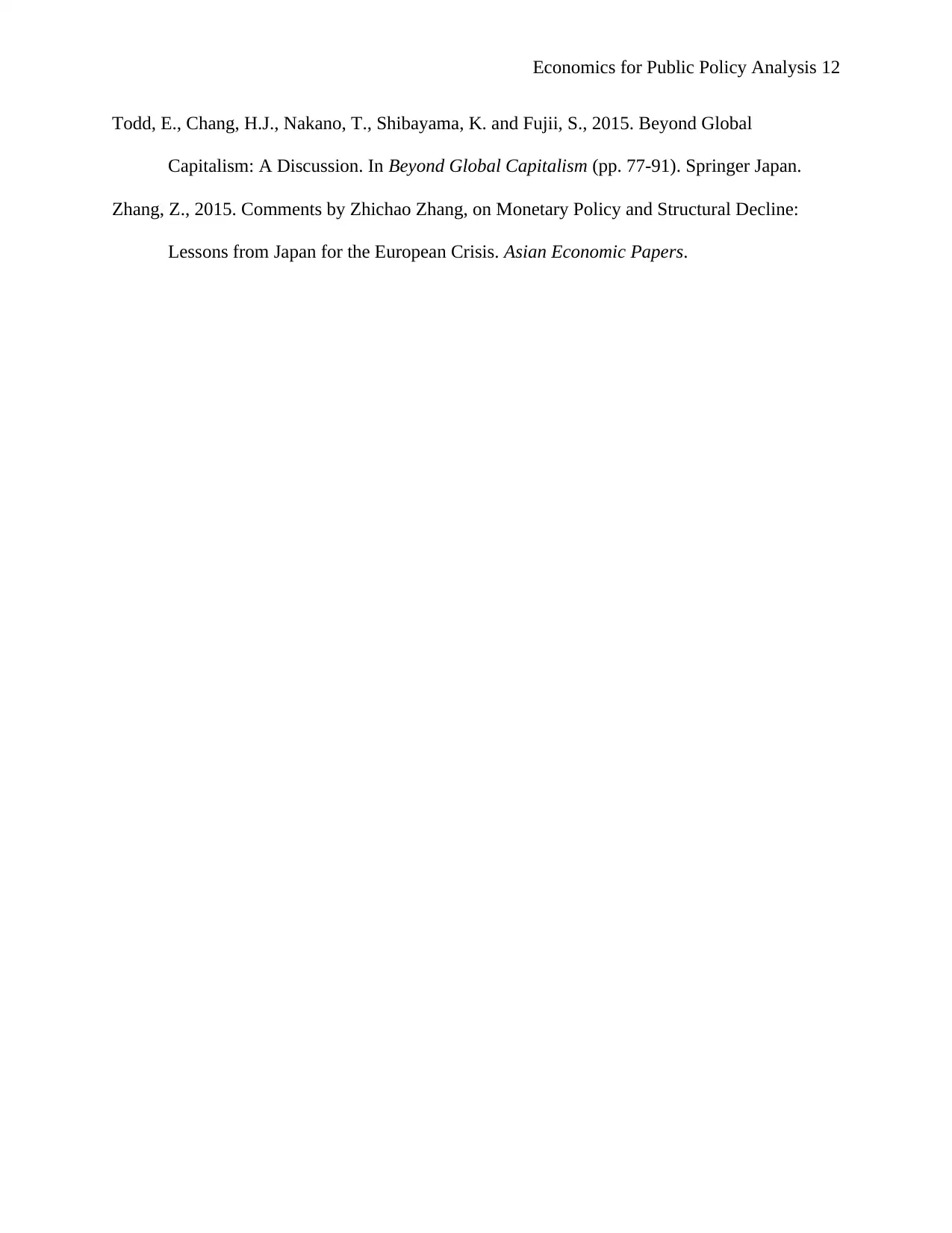
Economics for Public Policy Analysis 12
Todd, E., Chang, H.J., Nakano, T., Shibayama, K. and Fujii, S., 2015. Beyond Global
Capitalism: A Discussion. In Beyond Global Capitalism (pp. 77-91). Springer Japan.
Zhang, Z., 2015. Comments by Zhichao Zhang, on Monetary Policy and Structural Decline:
Lessons from Japan for the European Crisis. Asian Economic Papers.
Todd, E., Chang, H.J., Nakano, T., Shibayama, K. and Fujii, S., 2015. Beyond Global
Capitalism: A Discussion. In Beyond Global Capitalism (pp. 77-91). Springer Japan.
Zhang, Z., 2015. Comments by Zhichao Zhang, on Monetary Policy and Structural Decline:
Lessons from Japan for the European Crisis. Asian Economic Papers.
⊘ This is a preview!⊘
Do you want full access?
Subscribe today to unlock all pages.

Trusted by 1+ million students worldwide
1 out of 12
Related Documents
Your All-in-One AI-Powered Toolkit for Academic Success.
+13062052269
info@desklib.com
Available 24*7 on WhatsApp / Email
![[object Object]](/_next/static/media/star-bottom.7253800d.svg)
Unlock your academic potential
Copyright © 2020–2025 A2Z Services. All Rights Reserved. Developed and managed by ZUCOL.





